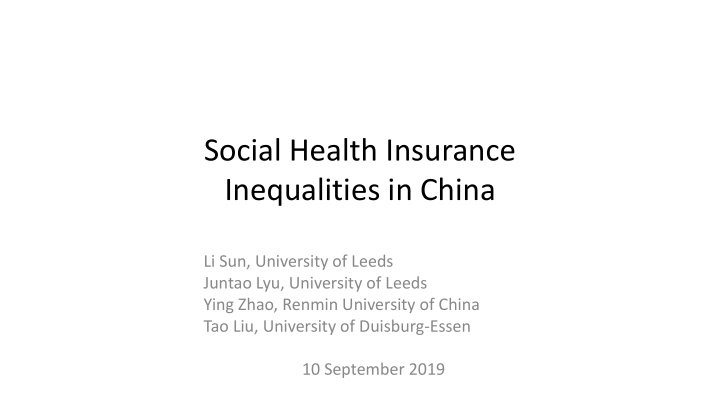



Social Health Insurance Inequalities in China Li Sun, University of Leeds Juntao Lyu, University of Leeds Ying Zhao, Renmin University of China Tao Liu, University of Duisburg-Essen 10 September 2019
Heath Insurance Policy Background in China – National basic health insurance enrolment • Hukou (household registration) based: NRCMI, URBMI • Employment based: UEBMI • Provincially various * NRCMI: New Rural Cooperative Medical Insurance * URBMI: Urban Residents Basic Medical Insurance * UEBMI: Urban Employee Basic Medical Insurance * Private health insurance (All available, but much more expensive than national basic health insurances)
Health insurance : entitlement and availability Entitled Available Urban local URBMI, UEBMI URBMI, UEBMI Urban-to-urban migrants URBMI, UEBMI UEBMI employment Rural local NRCMI NRCMI Rural-to-urban migrants NRCMI, UEBMI UEBMI * NRCMI: New Rural Cooperative Medical Insurance * URBMI: Urban Residents Basic Medical Insurance * UEBMI: Urban Employee Basic Medical Insurance * Private health insurance (All available, but much more expensive than national basic health insurances)
Hypothesis – Data source: • Chinese Livelihood Survey 2014, 8 Provinces, 9283 observations. – Hypothesis: Inequalities – Utilising formal health insurance health facilities benefits Social determinants (hukou, migration, occupation, or any others?) Self-medicating behaviours
Main aims of this research: • Examine health insurance inequalities both as to the level of benefits and the social consequences of health seeking behaviours (self-medicating behaviours); • Identify the key social determinants (socio-demographic characteristics) of these inequalities; and • Identify health insurance policy issues in China.
Methods – Multilevel linear regression modelling for health insurance benefits level – Multilevel logistic regression for self-medicating behaviour
Description: health insurance types
Description: sample provinces Sample provinces
Description: Health Insurance Enrolment
Modelling: dependent variables 1. Health insurance benefit level: reimbursement ratio (continuous variable, only for observations who attended hospitals) paid by medical insurance paid by medical insurance + paid out − of − pocket × 100%
2. Health seeking behaviours: self-medication (binary variable) When you or your family members are ill, what is your first option? 1. Self-medication: dealing with it yourself (health insurance not involved); 2. PHNs: visiting primary health networks doctors (hospitals or clinics in community and township level) 3. Tertiary hospitals: visiting the tertiary general hospitals (province or national level general hospitals)
Modelling: independent variables Socio-demographic factors
Health insurance benefit level: multilevel linear regression results
Self- medication: multilevel logistic regression results
Results Negative indicators that significantly lower medical insurance benefit levels: • Hukou status (migration): rural residents & rural-to-urban migrants • Occupation: informal sectors Self-medicating behaviours are significantly encouraged by: • Hukou status (migration): rural-to-urban migrants & urban-to-urban migrants • Occupation: informal sectors
Summary – Hukou status, migration and occupations are the main social determinants of health inequalities in China; – Rural-to-urban migrants & informal labourers have both significant lower health insurance benefit levels and higher self-medicating behaviours. They are not well protected by health insurance and more likely to resort to self-medication; – Health insurance policy in China needs to be adjusted to tackle migration-related challenges and informal employment challenges.
Summary • This is an unpublished paper, you are welcome to give suggestions or ask any questions. • All data analyses and slides are produced in R, all r coding scripts are available on my website: • https://jtlyu.com/ Presented by: Juntao Lyu – Doctoral Candidate – School of Sociology and Social Policy – University of Leeds | LS2 9JT – e-mail: ssjly@leeds.ac.uk
References – Wang, H.Q., Liu, Z.H., Zhang, Y.Z. and Luo, Z.J., 2012. Integration of current identity- based district-varied health insurance schemes in China: implications and challenges. Frontiers of Medicine, 6(1), pp.79-84. – Tao, R., 2008. Hukou reform and social security for migrant workers in China. In Labour migration and social development in contemporary China (pp. 87-109). Routledge. – Cooke, F., 2011. Labour market regulations and informal employment in China: To what extent are workers protected?. Journal of Chinese human resources management, 2(2), pp.100-116. – Park, A. and Cai, F., 2011. The informalization of the Chinese labor market. From iron rice bowl to informalization: Markets, workers, and the state in a changing China, 17. – Tang, S., Meng, Q., Chen, L., Bekedam, H., Evans, T. and Whitehead, M., 2008. Tackling the challenges to health equity in China. The Lancet, 372(9648), pp.1493-1501. – Wang, H., Xu, T. and Xu, J., 2007. Factors contributing to high costs and inequality in China’s health care system. JAMA, 298(16), pp.1928 -1930.
Recommend
More recommend